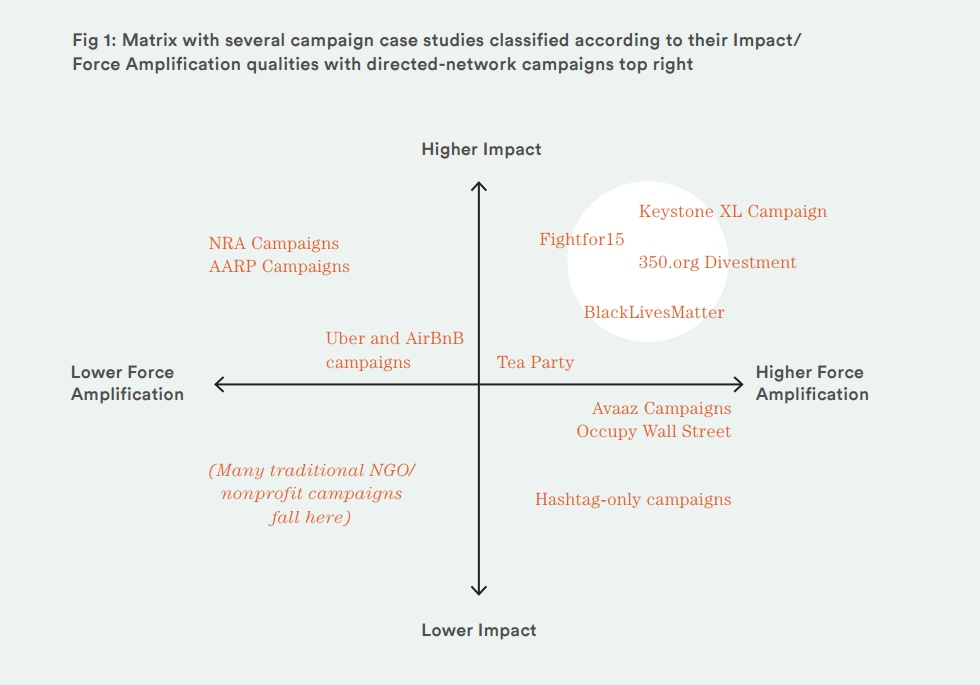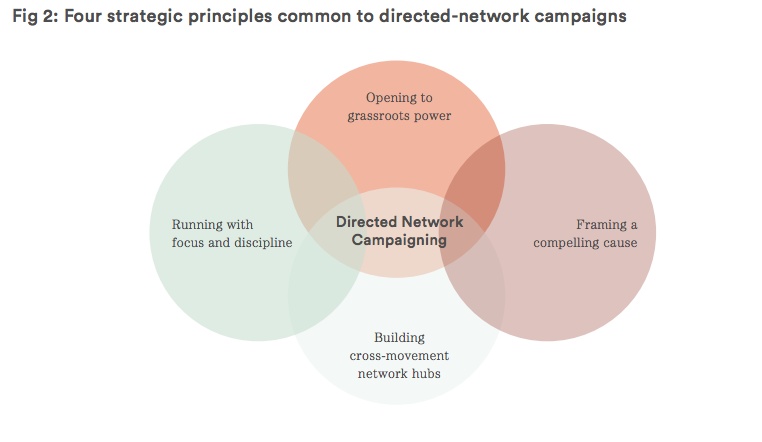This graph has got me thinking.

It comes from Networked Change, a report that anyone serious about thinking at what campaigning in the 21st century is going to look like needs to be reading.
Written by Jason Mogus, a consultant-cum-movement builders who’s work with a range of North American based networks it explores what are the characteristics of winning campaigns today.
In the report, Jason, with his co-author Tom Lucas, argue that those campaigns that are having the most impact and traction on issues today are those that adopt a networked approach.
It’s a theme that’s echoed in this piece by Nicole Carty, who accurately identifies that the most successful online campaigns a had ‘one essential thing in common — they had a sustained offline presence’.
Even before Brexit, I’ve been thinking if many of the campaigning models that NGOs are using aren’t fit for purpose our current age. But with Brexit and how we respond to it, it makes me feel that it’s even more important to take a long hard look and ask how do we ensure we continue to win.
Where are we at the moment?
Jason and Tom suggest that a typology for campaigning organisations and structures could be seen as;
Membership campaigns – these are hierarchical organisations, often as a result of a democratic structure at the heart of them which set direction (and sometimes elects who’ll run them). They’re built on a structure of local groups/chapters made up of individuals who pay to be part of the organisations.
As a result they often as a result have significant resources which are drawn from membership fees, That means the structure can be accompanied by resources for insider lobbying and influencing. In the UK, you might associate this model with the Trade Unions, although elements of the membership approach exist in organisations like Friends of the Earth and Amnesty International.
Managerial campaigns again are hierarchical, but the accountability isn’t to a democratic structure, but rather to the board or management team of the organisation. Many will have advisory groups of service uses or supporters, but those groups don’t have control over the direction of the activities.
These campaigns largely direct their grassroots into the actions they should be taking, and while those grassroots are mobilised regularly, the strategic direction is controlled, and there is an emphasis on brand and staying ‘on message’ over a freedom to innovate.
Many NGO campaigns are based on this approach and arguably emerged at a time when membership organisations were in decline, but people want to engage in activism but had less time to do so, so did so by making a donation.
Mass mobilisations platforms like Avaaz and 38 Degrees which utilise the power, as a result they can be nimble and responsive to the public mood, often the tools of the platform are available to others (see Campaigns By You from 38 Degrees) but there strength is combining mass mobilisation tools, like email petitions, with high profile activities. An importance is placed on the volume of activity rather than the depth of it.
Networked campaigns according to the report are ‘they are typically led by a central body that frames the issues and coordinates energies towards shared milestones but also leaves a fair amount of freedom and agency to grassroots supporters and a diverse network of inside and cross movement allies’.
I think it’s an accurate typology, and as I look around many of those involved in NGO campaigning seem to be trying to make the move from managerial campaigns to mass mobilisation platforms.
But while that could be the right move, if you follow the logic of the lessons from the report, campaigns that want to have impact should be looking to move from bottom left to top right, building campaign approaches that harness the power.
Jason and Tom suggest that networked campaigns have the following principles;

The report suggests that it’s a journey that can be made for NGO campaigning, although its’s not without its challenges.
How to respond?
So what are the steps that an organisation could take to start to make the move to taking a more networked approach? Here are some areas that could be explored first.
1 – Have super sharp political analysis – networked campaigns don’t relinquish control over the political strategy, they spot the opportunities and the weak points in their opponents. That can mean rethinking the targets and strategies to avoid asking people ‘to support an approach that is too arcane to grasp, too single-issue to make a difference, or to join a fight that seems hopeless from the beginning’ instead looking at ‘action worthy‘ problems where activism can be focused.
2 – Create ways to open feedback loops – those campaigns that succeed are ones that actively listen to those in their audience and then react and respond. According to the report ‘Active audience input and listening can take the form of polling supporters on future priorities, letting supporters suggest and initiate their own online petitions, and allowing supporters to generate their own digital campaign content through images and other forms of testimonials’.
3 – Give away more control – the most successful campaigns don’t try to control everything, but instead ‘allow their supporters to customize and adapt campaign messages and visuals to better suit their local contexts’. That doesn’t mean that anarchy has to rule, the report is clear that networked organisations ‘carefully outline roles and responsibilities for their distributed leadership, prepare a digital “toolkit” for self-starters and convene regular checkins led by central staff to ensure that problems are addressed and that the overall movement is aligned’.
4 – Make it about the issue not the brand – Managerial campaigns can often be accompanied with a strong focus on building brand profile – that’s a natural and rational decision as they’re often being funded solely by an organisations. The report suggests that ‘When the campaign is designed to be open from the beginning, to function more like a hashtag and a shared rallying point for a wider coalition of independent actors, this enables a shift from cause campaign to wider social movement, and the result is often much greater impact and reach’. While that makes lots of sense, what it doesn’t explore is how an organisation can fund such a campaign when the pressures to support activism can often be significant.
5 – Test, fail, adapt – being inspired by the tech world – networked campaigns are approaching campaigning by ‘Taking a product development approach to campaign design, organizers are led to work on rapid “iterations” of their plans and messaging with daily status check-ins between point people in various departments’. Be less risk adverse and failing fast are key characteristics.
6 – Actively look outside of usual networks – At the heart of networked organsiations are bridge builders, individuals who a comfortable operating in a networked way they are ‘network builders must actively seek out “unusual suspects”, groups that are not natural allies but are deeply impacted by campaign issues’. This by Lisa Witter is excellent on the skills that bridge builders need.
7 – Tell great stories – the report suggests that those campaigns that succeed are ones that are able to frame a compelling case. In short, they can tell a good story.
Jason and Tom draw from the work of Jonah Sachs and his Wining the Story Wars book in suggesting that campaigns need to frame messages with heroes and villains, but perhaps importantly adding that ‘Many of today’s most successful campaigns employ a storytelling strategy that casts their grassroots supporter base as the heroes in this story and give them an active role in taking the villain to task. The NGO is the mentor in the story, not the hero, and the language of “you” taking action and eventually prevailing replaces “we”.’
8 – Focus on organising to build power – I’ve explored this theme before, but perhaps this is one of the biggest difference between the networked approach that they advocate to the mass mobilisation platforms, suggesting that.
I think this quote in the report form Geoffrey MacDougall, at Consumer Reports nails it ‘“You can’t always be mobilizing. Without a clear end date or win state, you’ll just burn through people and build a machine you constantly need to feed just to stay at the same scale. Hold back your power until you’re at one of those 1/0 state moments, then go for broke.”
Networked Campaigns – a winning approach?
